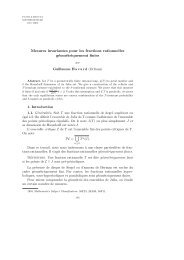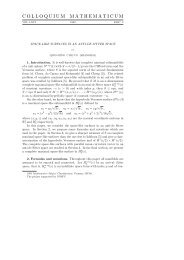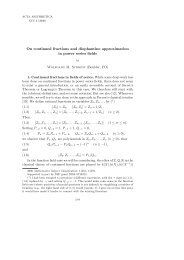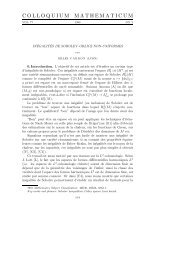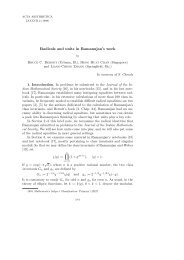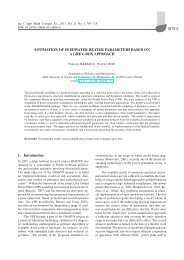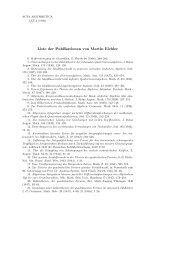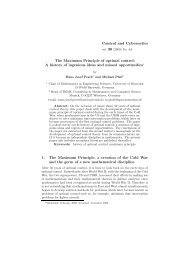DP2PN2Solver: A flexible dynamic programming solver software tool
DP2PN2Solver: A flexible dynamic programming solver software tool
DP2PN2Solver: A flexible dynamic programming solver software tool
You also want an ePaper? Increase the reach of your titles
YUMPU automatically turns print PDFs into web optimized ePapers that Google loves.
692 H. MAUCH<br />
SET_VARIABLES section. Such variables and set literals (described using complete<br />
enumeration, or a subrange syntax) can be operands of set theoretic operations<br />
like SETUNION, SETINTERSECTION or SETMINUS.<br />
Throughout a gDPS source it is legal to document it using C++/Java style<br />
block comments (between /* and */) and line comments (starting with //).<br />
Since the GENERAL_VARIABLES section allows the definition of arbitrary variables<br />
and the GENERAL_FUNCTIONS section allows the definition of arbitrary<br />
(computable) functions in a C++/Java style syntax, the gDPS language is powerful<br />
and <strong>flexible</strong>. Despite this power and flexibility, the other sections require<br />
a very structured format, which makes a gDPS very readable and produces a<br />
specification that resembles the mathematical formulation closely. The hybrid<br />
approach of <strong>flexible</strong> C++/Java style elements and strictly structured sections<br />
makes it easy to learn the gDPS language.<br />
Input data that is specific to a DP instance is hardwired into the gDPS<br />
source in order to have a single gDPS source file that contains the complete<br />
specification of the DP instance. If it seems more desirable to keep separate<br />
files for the instance specific data and the problem specific data, this would<br />
require a conceptually straightforward modification which we will not elaborate<br />
on any further here.<br />
<strong>DP2PN2Solver</strong>’s architecture is expandable and open to alternative source<br />
DP specification languages (see figure 1). For example, if the user desires to<br />
solve only very basic DP problems that involve only integer types as states or<br />
decisions, so that declarations are not necessary, then a much simpler language,<br />
the basic DP specification (bDPS) language, is sufficient. By adding a compiler<br />
to <strong>DP2PN2Solver</strong> that translates the bDPS into the Bellman net representation<br />
it becomes possible to use the other parts of the <strong>DP2PN2Solver</strong> system without<br />
any further changes. Even compilers for established mathematical <strong>programming</strong><br />
languages like AMPL, GAMS, OPL, or other languages mentioned in section 2<br />
can be envisioned. Those could easily be integrated into <strong>DP2PN2Solver</strong> (even<br />
though the development of the compiler itself might require a substantial initial<br />
implementation effort), so that users can write the DP specification in their<br />
favorite language.<br />
4.1. The matrix chain multiplication (MCM) problem example<br />
Given a product A1A2 · · · An of matrices of various (but still compatible) dimensions,<br />
the goal is to find a parenthesization, which minimizes the number of<br />
componentwise multiplications. The dimensions of Ai are denoted by di−1 and<br />
di. The DP functional equation can be expressed as<br />
�<br />
min<br />
f(i, j) = k∈{i,...,j−1} {f(i, k) + f(k + 1, j) + di−1dkdj} if i < j<br />
0 if i = j.<br />
The total number of componentwise multiplications is computed as f(1, n).<br />
(1)



